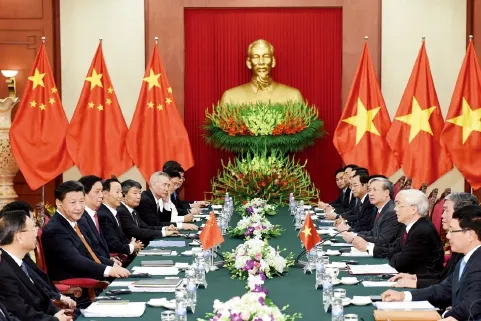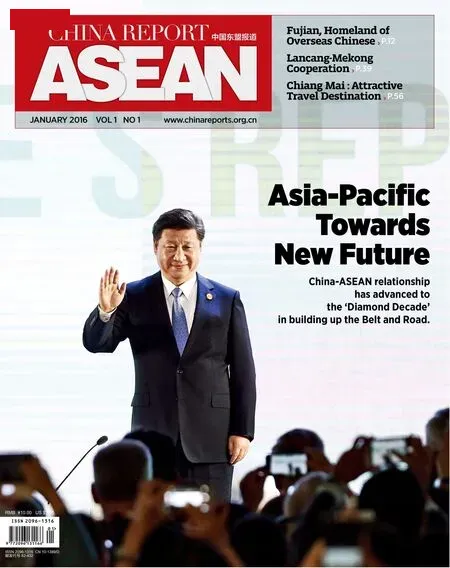Development Strategies Connected
By Staf Reporter Wang Yin
Development Strategies Connected
By Staf Reporter Wang Yin

On November 5, 2015, President Xi Jinping, who is also the General Secretary of the CPC Central Committee, held talks with Nguyen Phu Truong, General Secretary of the Central Committee of the Vietnamese Communist Party, in Hanoi.

Before the talks, General Secretary Nguyen Phu Truong held a grand welcome ceremony at the square of the Presidential Palace, where President Xi Jinping reviewed the guard of honor.
In 2013, Chinese President Xi Jinping proposed the initiative to build the Silk Road Economic Belt and the 21st Century Maritime Silk Road. Geographically, countries in Southeast Asia have been vital to the Maritime Silk Road since ancient times.
In November 2015, President Xi paid state visits to Vietnam and Singapore. China has been the biggest trade partner of Vietnam for 11 years running, and Vietnam the second biggest for China in ASEAN. Singapore is China's important partner, whose experience of development has provided benefcial reference for the reform and opening up of China. Meanwhile, China's development has brought huge opportunities for Singapore. China has become the largest trade partner of Singapore,and the latter is the biggest investor to China.
In the context of joining hands to build the 21st Century Maritime Silk Road and forging the upgrade of ACFTA, it was certainly the right time for President Xi to visit Vietnam and Singapore.
Cooperation of Development Strategies
In May 2004, the then Prime Minister of Vietnam, Phan Van Khai, proposed to China to build the Kunming (China)-Lao Cai-Hanoi-Haiphong-Quang Ninh economic corridor,the Nanning (China)-Lang Son-Hanoi-Haiphong-Quang Ninh economic corridor,and the Pan-Beibu Bay economic circle. The two corridors and one economic circle connect 10 coastal areas in China and Vietnam,through which Vietnam hopes to promote an economic boom.
The cooperation between the Belt and Road Initiative and the Two Corridors and One Economic Circle is expected to bring huge opportunities for China and Vietnam and their businesses to gain mutual benefit, as well as well-being for the two peoples. This is one of the major achievements President Xi Jinping made with his visit to Vietnam.
In the Joint Communiqué between the PRC and the Socialist Republic of Vietnam issued on Nov 6, 2015, consensus was reached on carrying out the surest cooperation in development strategies, integrating their strengths,and expanding cooperation within the framework of China's Belt and Road Initiative and Vietnam's Two Corridors and One Economic Circle.
“Enhancing cooperation in the production capacity in many felds and concentrating on large projects “ is a statement in the joint communiqué that has come into practice.
Power shortage is a common headache for the people of Vietnam. How to solve this problem is on top of the agenda of the Vietnamese government for economic development.
In northern Vietnam abutting China,the China Southern Power Grid developed a pattern to send electricity from Yunnan and Guangxi to Vietnam through triple-circuit 220V lines and triple-circuit 110V lines, helping seven provinces of Vietnam, including Lao Cai, gain access to reliable power. As of the end of 2014, the China Southern Power Grid had transmitted 29.2 billion kWh of electricity to Vietnam.
Interconnectivity is an important part of the Belt and Road Initiative. A case in point is the transnational power grid between China and Vietnam. It also sets a good example for promoting cooperation within the framework of the Two Corridors and One Economic Circle and building a community of common destiny.
Te Phase-I BOT project of the Vinh Tan Coal-Fired Power Plant in Tuy Phong, Binh Thuan Province is the biggest investment of Chinese enterprises. The China Southern Power Grid, the China Power International Development, and Vinacomin hold equity shares of 55, 40 and 5 percent, respectively. It is expected to invest $1.755 billion in two 600,000 kW supercritical coal-fred units.
Zhang Tanzhi, President of the Shareholders' Committee, said the project adopted the most advanced technology of power generation in China and made use of the supercritical units in favor of environmental protection. As Vietnam's frst power plant applying the technology of supercritical W-fame boiler, it is a boon to help upgrade the country's power industry.
Te franchise will operate for 25 years. On expiration, ownership will be transferred to theVietnamese government free of charge.

On November 6, 2015, President Xi Jinping met with Singaporean President Tony Tan Keng Yam in Singapore.

On November 7, 2015, President Xi Jinping held talks with Singaporean Prime Minister Lee Hsien Loong in Singapore.
“I hope that the project will come into operation as soon as possible. I hope to see investors gain profts, because, only in that way,can it create tax, promote the local economy,and attract more investors to Binh Thuan,”said Le Tien Phuong, Chairman of Binh Tuan Province's People's Committee.
China-Singapore Cooperation
Te Joint Statement between the PRC and the Republic of Singapore on the Establishment of an All-Round Cooperative Partnership Progressing with the Times released on Nov 7, 2015 fully shows the new positioning of their relationship after President Xi's visit. According to Singapore President Tony Tan and Prime Minister Lee Hsien Loong, judging from the experiences over the past 25 years,the more China develops and opens up, the more opportunities Singapore has to improve their relations. In the Joint Statement, the two countries agreed to redefne their ties as a“partnership of all-round cooperation keeping with times”.
For instance, President Xi and his Singapore counterpart agreed on joint research to achieve an upgrade of the China-Singapore Free Trade Agreement (CSFTA). On this basis,the CSFTA will be upgraded in a comprehensive and balanced way for mutual beneft,which involves trade in goods, services and investment. According to the Joint Statement,China and Singapore are set to launch the negotiation on the FTA upgrade, and do everything possible to conclude it in 2016.
Singapore is an important port in the world and a renowned fnancial center in Asia. During Xi's visit, the two countries decided to expand the use of RMB in bilateral trade and investment, make good use of the RMB Clearing Bank in Singapore, and carry out exchanges and cooperation in fnancial regulation.
Apart from that, China and Singapore will launch regular top-level dialogue among securities regulators to discuss the cooperation on regulation and product development, and enhance the cooperation of capital markets of the two countries.
For example, the third intergovernmental cooperation project, the China-Singapore Demonstration Project on Strategic Connectivity, designates Chongqing, one of the 4 municipalities directly under the Central Government of China, as the operation center. The Project sets financial services, aviation,transportation, logistics, and IT technology as the key areas of cooperation. It follows the Belt and Road Initiative, the Western Region Development Campaign and the development strategy of the Yangtze River Economic Belt,destined to be an innovative demonstration project featuring “modern interconnectivity and service economy”.
President Xi's visit to Vietnam sought to build a community of common destiny with the same goal and interest. The visit to Singapore redefned China-Singapore ties as a partnership of all-round cooperation keeping with the times. He profoundly expounded the good-neighbor policy of China and displayed the prosperous prospect of common development.
Chinese Foreign Minister Wang Yi told reporters that President Xi's visits not only built a new important understanding, and created a new cooperative prospect, but also made it possible for the region and the world at large to have a new understanding and recognition of the domestic and foreign policies of China.
Links: Major Achievements of President Xi Jinping's Visit to Vietnam and Singapore
China and Vietnam
Implementing the plan of cooperation between the two Parties, deepening exchanges and cooperation between the departments and local governments of the Central Committees of the two Parties, especially the Party organizations in the contiguous provinces (autonomous regions).
Strengthening cooperation in the development strategies between the two countries, promoting cooperation between the Belt and Road Initiative and the Two Corridors and One Economic Circle, and registering more cooperation in productivity in building materials, auxiliary industry,manufacturing and renewable energy.
Exploring more cooperation in the fields of science,technology, education, culture, tourism and news.
Joining hands to manage the maritime disputes,comprehensively implement the Declaration on the Conduct of Parties (DOC), making efforts to accomplish the Code of Conduct in the South China Sea (COC) on the basis of consensus through consultation, instead of actions making the disputes more complicated and exaggerated, properly handling the emerging issues, and safeguarding the overall relationship between China and Vietnam and the peace and stability of the South China Sea.
China and Singapore
China and Singapore agreed to negotiate a CSFTA upgrade hopefully within 2016.
Singapore supported the RMB to be included in the IMF's SDR basket of currencies.
Promoting the development of the China-Singapore Suzhou Industrial Park and Tianjin Eco-City.
Fully drawing on support to the China-Singapore(Chongqing) Demonstration Initiative on Strategic Connectivity.
Promoting discussion on the potential to expand Freedoms of the Air framework between China and Singapore,upgrading the status of the international airports of the two countries, enhancing people-to-people exchanges, exploring and deepening economic cooperation, and reinforcing cultural exchanges.
Seeking new approaches in the scheme for the China-Singapore Joint Council for Bilateral Cooperation to enhance sci-tech innovation and cooperation. Promoting the cooperation in eco-environment protection, water treatment,agriculture, food security, and customs enforcement for facilitating trade as for the two customs.
Source: Xinhua, People's Daily
- China Report Asean的其它文章
- Filial Piety First Thai Veteran Statesman Suwat's Principle in Life and Politics
- Asia-Pacifc Effort for Inclusive Economies
- Asia-Pacific Towards New Future
- Fujian, Homeland of Overseas Chinese Interview with Fujian Returned Overseas Chinese Federation Chairperson Wang Yajun
- Top 10 Chinese Entrepreneurs under 40
- Asia-Pacifc: Fueling World Economy

